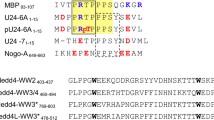Summary
Murine cytomegalovirus (MCMV) IE3 protein is a multifunctional viral protein that interacts with several target proteins of both viral and host cellular origin. To investigate the biological function of IE3 in the pathogenesis of the brain disorders caused by CMV, a screening for host cellular proteins that could interact with IE3 was performed. By yeast two-hybrid screening, ankyrin repeats domain 17 (Ankrd17, also known as Gtar) was identified as a host factor that could interact with IE3. This interaction was verified by yeast two-hybrid assay and chemiluminescent co-immunoprecipitaion. Mapping analysis suggested that the 1–148 residues of IE3 were responsible for the interaction. These results suggested that the interaction between Ankrd17 and IE3 may play a key role in the pathogenesis of MCMV-associated disease.
Similar content being viewed by others
References
Griffiths P. Cytomegalovirus infection of the central nervous system. Herpes, 2004,11(Suppl 2):95A–104A
Hollier L M, Grissom H. Human herpes viruses in pregnancy: cytomegalovirus, Epstein-Barr virus, and varicella zoster virus. Clin Perinatol, 2005,32(3):671–696
Sinzer C, Jahn G. Human cytomegalovirus cell tropism and pathogenesis. Intervirology, 1996,39(5–6):302–319
Reddehase MJ, Simon CO, Seckert CK, et al. Murine model of cytomegalovirus latency and reactivation. Curr Top Microbiol Immunol, 2008,325:315–331
Tsutsui Y, Kosugi I, Kawasaki H. Neuropathogensis in cytomegalovirus infection: indication of the mechanisms using mouse models. Rev Med Virol, 2005,15(5):327–345
Reddehase MJ, Podlech J, Grzimek NK. Mouse models of cytomegalovirus latency: overview. J Clin Virol, 2002,25(Suppl 2):S23–36
Li RY, Baba S, Kosugi I, et al. Activation of murine cytomegalovirus immediate-early promoter in cerebral ventricular zone and glial progenitor cells in transgenic mice. Glia, 2001,35(1):41–52
Ghazal P, Messerle M, Osborn K, et al. An essential role of the enhancer for murine cytomegalovirus in vivo growth and pathogenesis. J Virol, 2003,77(5):3217–3228
Angulo A, Ghazal P, Messerle M. The major immediate-early gene ie3 of mouse cytomegalovirus is essential for viral growth. J Virol, 2000,74(23):11129–11136
Tang Q, Li L, Maul GG. Mouse cytomegalovirus early M112/113 proteins control the repressive effect of IE3 on the major immediate-early promoter. J Virol, 2005,79(1): 257–263
Benoit RM, Wilhelm RN, Scherer-Becker D, et al. An improved method for fast, robust, and seamless integration of DNA fragments into multiple plasmids. Protein Expr Purif, 2006,45(1):66–71
Messerle M, Buhler B, Keil GM. et al. Structural organization, expression, and functional characterization of the murine cytomegalovirus immediate-early gene 3. J Virol, 1992,66(1):27–36
Maul GG, Negorev D. Differences between mouse and human cytomegalovirus interactions with their respective hosts at immediate early times of the replication cycle. Med Microbiol Immunol, 2008,197(2):241–249
Martínez FP, Cosme RS, Tang Q. Murine cytomegalovirus major immediate-early protein 3 interacts with cellular and viral proteins in viral DNA replication compartments and is important for early gene activation. J Gen Virol, 2010,91(Pt 11):2664–2676
Hou SC, Chan LW, Chou YC, et al. Ankrd17, an ubiquitously expressed ankyrin factor, is essential for the vascular integrity during embryogenesis. FEBS Lett, 2009, 583(17):2765–2771
Deng M, Li F, Ballif BA, Li S, et al. Identification and functional analysis of a novel cyclin e/cdk2 substrate ankrd17. J Biol Chem, 2009,284(12):7875–7888
Guan H, Kiss-Toth E. Advanced technologies for studies on protein interactomes. Adv Biochem Engin/Biotechnol, 2008,110:1–24
Ratushny V, Golemis E. Resolving the network of cell signaling pathways using the evolving yeast two-hybrid system. Biotechniques, 2008,44(5):655–662
Luo D, Shu SN, Tian J, et al. Experimental study of the influence of murine cytomegalovirus infection on cell cycle progression and cyclins expression of neural stem cells in vitro. Chin J Neuroanatomy, 2010,26(1):1–8
Wiebusch L, Neuwirth A, Grabenhenrich L, et al. Cell cycle-independent expression of immediate-early gene 3 results in G1 and G2 arrest in murine cytomegalovirus-infected cells. J Virol, 2008,82(20):10188–10198
Author information
Authors and Affiliations
Corresponding author
Additional information
This project was supported by a grant from National Natural Sciences Foundation of China (No. 30671859).
Rights and permissions
About this article
Cite this article
Wang, H., Liu, X., Shu, S. et al. Murine cytomegalovirus IE3 protein interacts with Ankrd17. J. Huazhong Univ. Sci. Technol. [Med. Sci.] 31, 285–289 (2011). https://doi.org/10.1007/s11596-011-0368-5
Received:
Published:
Issue Date:
DOI: https://doi.org/10.1007/s11596-011-0368-5




